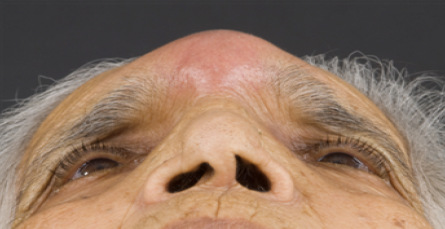Instances are rare and early detection is essential.
Case
Patient was an 84-year-old female who presented to the urgent care complaining of painful forehead swelling for two days. She denied trauma, vision changes, sinus congestion/drainage, pharyngitis or previous episodes of similar symptoms.
She also denied fever, loss of consciousness, dizziness, nausea/vomiting or balance problems. Her past medical history included recurrent sinusitis, rheumatoid arthritis, and hyperlipidemia, and her medications included Lovastatin, Mobic and aspirin. She had no known allergies, no pertinent surgeries or social history. On exam, she had prominent, fluctuant swelling on the left side of her forehead with mild ptosis and swelling of the upper eyelids.
Her nasal mucosa was inflamed with complete obstruction of the left middle meatus. The rest of the physical exam was unremarkable. She was afebrile, hypertensive at 165/88, and slightly tachycardic at 102. Pott’s Puffy Tumor was suspected, and the patient was immediately referred to the emergency department.
Treatment
Upon arrival to the hospital, the patient remained afebrile with a blood pressure of 181/96, and a heart rate of 94. A sepsis protocol was initiated. The white cell count with differential, lactic acid and the PT/INR were normal while the glucose was elevated at 117, and the anion gap was 13.
CT Brain/Head without contrast and CT Maxillofacial without contrast were ordered. Both scans revealed extensive, multifocal paranasal sinus inflammatory disease, greatest in the left frontal sinus with cortical thinning and erosion of the anterior/medial margin, consistent with osteomyelitis.

The overlying forehead soft tissue swelling was compatible with Pott’s Puffy Tumor. Internal medicine, infectious disease and otorhinolaryngology were consulted, and Meropenem and Vancomycin were started for empiric therapy.
Operation was completed five days after admission and consisted of a left endoscopic frontal sinusotomy with subperiosteal abscess drainage, bilateral endoscopic total ethmoidectomy and bilateral endoscopic maxillary anthrostomy with tissue removal.
Surprisingly, the blood, nasal, and sinus cultures were normal. The ENT specialist surmised that the sinus/nasal cultures were normal due to a lab error or the fact that the patient already had 24 hours of antibiotic treatment.
After discharge, the patient received six weeks of intravenous Cefepime and oral Flagyl as well as steroids and nasal saline. She has fully recovered and continues her compliance with otorhinolaryngology follow-up.
History
Pott’s Puffy Tumor was first described in the 1760s by Sir Percival Pott. His patient developed forehead swelling following head trauma. Reports of the condition have been rare, but it seems to occur most commonly in adolescents with frontal sinusitis. Symptoms can range from periorbital and/or forehead swelling to purulent rhinorrhea, fever and neurological deficits.
Cultures of pus often reveal Strepococcus/Staphylococcus species, Klebsiella or Haemophilis influenza. The infection can be polymicrobial, so antibiotic treatment should include coverage of anaerobes. Complications can include meningitis, epidural and subdural abscesses, and sinus thrombosis. The differential diagnoses can include infected cysts, hematomas, non-Hodgkin’s lymphoma and carcinomas.
A CT scan is the gold standard in the emergency department, and collaboration with specialists such as otorhinolaryngology and infectious disease is a must.
Though Pott’s Puffy Tumor is rare in adolescents, and even rarer in the elderly, the provider must be familiar with this entity. Otherwise, patients could face severe consequences, including death.
Photo Credit:
Copyright: © 2014 Khan MM, et al. This is an open-access article distributed under the terms of the Creative Commons Attribution License, which permits unrestricted use, distribution, and reproduction in any medium, provided the original author and source are credited.









